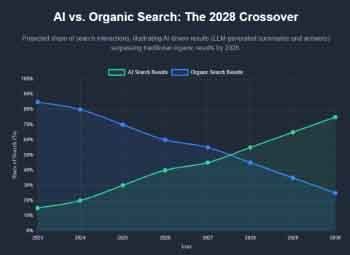We got it.
Thank you for contacting us.We’ll get back to you as soon as possible.
SEO and GEO: Why This Power Couple is the Future of Your B2B Search Strategy
By Doug Mansfield • 8 October 2025

The way your customers find you online is undergoing a seismic shift. For years, Search Engine Optimization (SEO) has been the undisputed champion for getting your business noticed on Google and Bing. But with the rise of AI Search Results and AI-powered tools like Google Gemini and ChatGPT, a new, conversational search landscape has emerged. This is the world of Generative Engine Optimization (GEO).
Many B2B companies now wonder, "Should we focus on SEO or GEO?"
The answer is simple: That's the wrong question. The real key to dominating the future of search is to understand that
SEO and GEO are symbiotic . They aren't competing priorities; they are two sides of the same coin. If you are pursuing one, it only makes sense to pursue both.
Your SEO Efforts Have Already Paved the Way for GEO
If you have an active SEO campaign, the good news is that the technical groundwork for a successful GEO strategy is likely already in place. This foundation consists of two critical elements:
- A Well-Structured Website: At a technical level, search engines and AI models need to crawl and understand your site. This is made possible by files like
robots.txt(which tells them which pages to look at) and asitemap.xmlfile (which provides a map of your content). If your website is built on a modern platform like WordPress, Wix, Squarespace, or Shopify, these files are almost certainly in place and working, even if you’ve never seen them. - Carefully Crafted Content: Great SEO requires great content. This content, which you've already invested in, is the fuel for both SEO and GEO.
Pro tip: Check to see if your website is open to search engine spiders and AI search content spiders using our free
Robots.txt File Assessment Tool
The technical part is the barrier to entry. It’s the quality of your content and the manner in which it’s published that determine whether you become visible in the AI-powered answers that define GEO.
E-E-A-T: The Shared Language of Trust for Search Engines and AI
In the world of SEO, Google uses a core principle known as
E-E-A-T :
- Experience: Do you have real, first-hand experience in your subject?
- Expertise: Do you have specialized knowledge and skill?
- Authoritativeness: Are you a recognized, go-to source in your industry?
- Trustworthiness: Is your site secure, reliable, and your information accurate?
These same principles are fundamental to both SEO and GEO. Traditional search engines use them to rank websites. Generative AI models use them to determine which sources to trust and cite when formulating an answer. By creating content that demonstrates E-E-A-T, you’re simultaneously telling Google you’re a credible resource for its rankings and telling AI models you’re a reliable source for their answers.
The Content Balancing Act: When to Sell and When to Help
Here’s where strategy becomes crucial. Your website has to do two things at once: convert ready-to-buy prospects and build trust with those still in the research phase. This requires two different modes of communication.
1. Sales-Focused Content (For Human Conversion) Your main product and service pages need to use "sales speak." This is where you make bold claims about your offerings, highlight your unique value, and use strong calls-to-action to drive sales conversions. This content is designed for a human who is actively looking to solve a problem and needs to be convinced that you are the right choice.
2. Helpful, Nuanced Content (For GEO and Trust-Building) However, GEO requires a more nuanced approach. AI models are designed to genuinely help users by answering their questions and solving their problems. If every page on your website seeks first and foremost to sell something, you will be at a disadvantage. AI is less likely to feature overtly commercial content as a helpful, unbiased answer.
To succeed in GEO, you must create a mix of content. You need articles and resources that seek to educate and enlighten people before you jump into the sales pitch. This builds the authority and trustworthiness that both AI models and human prospects are looking for.
B2B Blog Post Titles that Prioritize Helping Over Selling
So, what does this helpful content look like in practice? Instead of "Buy Our CNC Machines," consider titles that address your prospect's actual problems and questions. Here are a few B2B examples:
- For a logistics company: "How to Choose the Right Freight Class to Avoid Costly Shipping Errors"
- For a cybersecurity firm: "5 Telltale Signs Your Business is the Target of a Phishing Attack"
- For an industrial equipment supplier: "A Maintenance Checklist for Extending the Lifespan of Your Hydraulic Systems"
- For a software provider: "ROI vs. TCO: Which Metric Matters More When Evaluating New ERP Software?"
- For a construction firm: "Navigating Permit Delays: A Project Manager's Guide to Keeping Your Build on Schedule"
Each of these titles promises to solve a problem or answer a question. They build trust by providing value upfront. A prospect who finds your helpful article is far more likely to see you as an expert and turn to you when they are finally ready to buy.
Unify Your Strategy for a Stronger Bottom Line
SEO and GEO are not separate disciplines; they are a unified front in the evolving battle for digital visibility. Your SEO provides the technical foundation, the principles of E-E-A-T provide the philosophical guide, and a balanced content strategy provide the engine for growth.
By creating content that both sells to motivated buyers and educates curious researchers, you position your brand to win in traditional search rankings and become the trusted voice in the new era of AI search.
Ready to bridge the gap between your SEO and GEO strategies?
Contact Mansfield today for a free evaluation to see how we can align your marketing to empower your sales team and increase conversions that affect your bottom line.
Latest Posts













